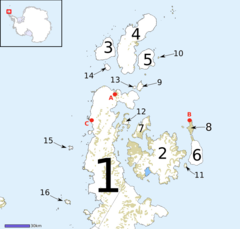| Hidden Lake Formation | |
|---|---|
| Stratigraphic range: Coniacian[1] | |
| Type | Geological formation |
| Unit of | Gustav Group |
| Underlies | Santa Marta Formation |
| Overlies | Whisky Bay Formation |
| Lithology | |
| Primary | Sandstone |
| Other | Siltstone |
| Location | |
| Coordinates | 63°00′S 57°00′W / 63.0°S 57.0°W |
| Approximate paleocoordinates | 63°06′S 63°54′W / 63.1°S 63.9°W |
| Region | James Ross Island, James Ross Island group |
| Country | Antarctica |
| Type section | |
| Named for | Hidden Lake |
 Map of James Ross Island group James Ross Island is number 2 | |
The Hidden Lake Formation is a Late Cretaceous geologic formation in Antarctica. The sandstones and siltstones of the formation were deposited in a deltaic environment.
Indeterminate megalosaur remains have been recovered from it.[2] Also many plant fossils and ichnofossils of Planolites sp. and Palaeophycus sp. have been found in the formation.[3]
YouTube Encyclopedic
-
1/3Views:1 1636 813369
-
Hidden Lake Lookout
-
The hidden lake under the Garnier Opera | INA Archive
-
Hidden Lake Peak
Transcription
Paleofauna
- Megalosauroidea indet.[2]
- Palaeophycus sp.[3]
- Planolites sp.[3]
Flora
- Antarctoxylon mixai[4]
- Dicotylophyllum[5]
- Elatocladus cf. heterophylla[5]
- Lygodium sp.[5]
- Microphyllopteris sp.[5]
See also
References
- ^ Crame, J. A.; Pirrie, D.; Riding, J. B. (2006). "Mid-Cretaceous stratigraphy of the James Ross Basin, Antarctica". Geological Society, London, Special Publications. 258 (1): 7–19. doi:10.1144/GSL.SP.2006.258.01.02. ISSN 0305-8719.
- ^ a b Weishampel, et al. (2004). "Dinosaur distribution" pp. 517–607. in Weishampel, David B.; Dodson, Peter; and Osmólska, Halszka (eds.): The Dinosauria, 2nd, Berkeley: University of California Press. 861 pp. ISBN 0-520-24209-2. " pp. 517–607.
- ^ a b c Hidden Lake at Fossilworks.org
- ^ Sakala, Jakub; Vodrážka, Radek (August 2014). "A new species of Antarctoxylon : a contribution to the early angiosperm ecosystem of Antarctica during the late Cretaceous". Antarctic Science. 26 (4): 371–376. doi:10.1017/S095410201300076X. ISSN 0954-1020.
- ^ a b c d Kvaček, Jiří; Sakala, Jakub (2011-06-01). "Late Cretaceous flora of James Ross Island (Antarctica) – preliminary report". Czech Polar Reports. 1 (2): 96–103. doi:10.5817/CPR2011-2-9. ISSN 1805-0697.
Further reading
- V. D. Barreda, S. Palamarczuk, and F. Medina. 1999. Palinología de la Formación Hidden Lake (Coniaciano-Santoniano), Isla James Ross, Antártida. Revista Española de Micropaleontología (31)53-72
- R. E. Molnar, A. L. Angriman, and Z. Gasparini. 1996. An Antarctic Cretaceous theropod. Memoirs of the Queensland Museum 39(3):669-674
- D. Néraudeau, A. Crame, and M. Kooser. 2000. Upper Cretaceous echinoids from James Ross Basin, Antarctica. Géobios 33(4):455-466
